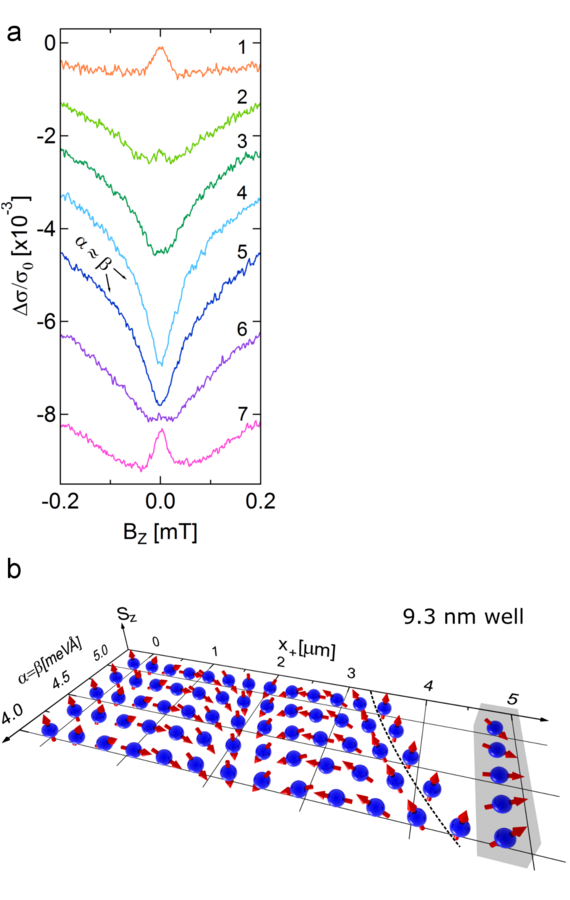Spin-Orbit Interaction in a GaAs quantum well

F. Dettwiler, J. Fu, S. Mack, P. J. Weigele, J. C. Egues, D. D. Awschalom and D. M. Zumbühl
"Stretchable persistent spin helices in GaAs quantum wells",
Phys. Rev. X 7, 031010 (2017), manuscript pdf, supporting material pdf
UniNews 19.07.2017: "Manipulating electron spins without loss of information"
Motivation
In this project we focus on control and detection of spin orbit (SO) interaction in GaAs quantum wells at millikelvin temperatures from transport measurements.
Quantum corrections to the conductivity due to interference of coherently backscattered paths depend on magnetic field and SO coupling. In particular weak anti localization is a well-known signature for SO coupling in transport experiments and thus lends itself as an ideal tool to extract and detect SO coupling parameters. In zincblende structures the two dominant contributions to SO coupling are the Rashba and Dresselhaus fields, with their strength denoted by α and β respectively.
Methods and Results
We employ the suppression of weak anti localization in low temperature transport measurements to detect matched Rashba and Dresselhaus SO fields, i.e., α=β. In this case an interesting situation emerges: The effective SO field becomes uniaxial and the spin precession only depends on the distance the electron has traveled and spin relaxation is suppressed, giving its name persistent spin helix (PSH) [1,2].
By using a top gate voltage VT and a back gate voltage VB, we demonstrate for the first time control of the renormalized Dresselhaus term β. Simultaneously and independently, we use the same gates to control the Rashba term α. Thus, we are able to control both α and β independently and continuously with VT and VB, while keeping them locked to equal strength. This makes possible a new concept: the stretchable PSH, i.e., a helical spin pattern with continuously variable pitch, controllable over a wide parameter range [3]. The stretchable PSH protects spins from decay while electrically controlling the spin precession. In this regime, quantum transport is diffusive (2D) for charge while ballistic (1D) for spin, thus amenable to coherent spin control. Stretchable PSHs provide a platform for the much heralded long-distance communication and can be used to generate new spin patterns such as a skyrmion lattice (crossed helices) with variable lattice constants [4].
Furthermore, we developed a new analytical expression for weak antilocalization, valid around the PSH state, which includes the complete Rashba and Dresselhaus SO fields. Using this expression we extract all SO couplings as functions of VB and VT, which agree remarkably well with numerical simulations.
Outlook
The ability to quantify the SO parameters in a direct and unambiguous way will play an important role in the design of future spintronic devices.
[1] J. Schliemann, J. C. Egues, and D. Loss, Nonballistic Spin-Field-Transistor, Physical Review Letters 90, 146801 (2003)
[2] B. A. Bernevig, J. Orenstein, and S.-C. Zhang, Exact SU(2) Symmetry and Persistent Spin Helix in a Spin-Orbit Coupled System, Physical Review Letters 97, 236601 (2006).
[3] F. Dettwiler, J. Fu, S. Mack, P. J. Weigele, J. C. Egues, D. D. Awschalom, and D. M. Zumbühl, Stretchable Persistent Spin Helices in GaAs Quantum Wells, Phys. Rev. X (accepted), arXiv:1702.05190
[4] J. Fu, P. H. Penteado, M. O. Hachiya, D. Loss, and J. C. Egues, Persistent Skyrmion Lattice of Noninteracting Electrons with Spin-Orbit Coupling, Physical Review Letters 117, 226401 (2016).
Figures
a: Magnetoconductance traces at different strengths of a and b, which are tuned with the gate voltages. At matched Rashba and Dresselhaus (α=β), weak anti-localization (traces 1-3 and 6&7) is suppressed and weak localization appears (traces 4&5).
b: Concept of a stretchable persistent spin helix: The electron spin rotates in a helical pattern along its path. By changing the gate voltages such that α/β=1 but changing their strength one can vary the distance needed for a full 2π rotation of the spin. This also enables to controllably rotate the spin at any position (see gray box).
